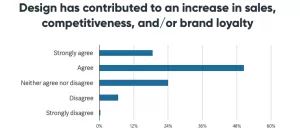- News
Earlier in the year Clearleft asked 400 designers from around the world about how design functions within their organisations. We uncovered some fascinating insights around the effectiveness and implementation of design within organisations which we recently published, but here we’ll reveal one vital contributing factor to design being successful.
One of the pivotal opinions we gauged was whether designers thought design within their organisation “has contributed to an increase in sales, competitiveness, and/or brand loyalty”. In other words, is design having an impact on the end goals of their organisation?

We found that 69% of designers agreed that design has had a positive impact towards the success of their organisation. Only 7% felt that design was not having an impact. A quarter of designers weren’t sure whether or not they were making a difference (the not-knowing tells a story in itself, but that’s for another time).
It’s fair to say that designers are self-reporting the impact of their work. Some of this will be quantified and much might be subjective opinion. If you consider that we designers can be a cynical bunch and that, as an anonymous survey, there was no reason to justify one’s position, we can take these results as indicative.
At Clearleft we believe that research has an important role to play in design, so we were keen to also determine how much design research took place in organisations.

We found that the majority (53%) of organisations had little to no design research taking place. Given that all the organisations in question had at least one designer, this was slightly disappointing, although in our experience not entirely surprising. It was heartening to see that over 10% of organisations were doing design research at scale.
Firm in our belief that design research is important, we cross-referenced research with design impact to see if there was any correlation. That was when the true effect of design research was revealed.

Of the organisations where regular design research was being undertaken, 82% agreed that design was increasing sales, competitiveness, and/or brand loyalty. Doing research is one of the main differences between the design teams that impact business and those that don’t.

Over half of design teams that have contributed to an increase in sales, competitiveness, and/or brand loyalty do design research regularly or at scale. In contrast, of those organisations where design was not having an impact, 95% are undertaking little to no design research.
The takeaways here are twofold. A design team is likely to contribute to the goals of an organisation. However without regular research to inform design, that work is far less likely to have an impact. Leaving differences aside, there’s still lots of room for improvement for most design teams in terms of research practice.
The companies performing the best in this regard have integrated research and design teams, or are set up with research and design distributed throughout the organisation. The work of those disciplines is shared with the rest of the employees so that research and design become fundamental to the decision making and strategy of the organisation.
Read the full Design Effectiveness report.
Related thinking
- Viewpoint
The usability of deliverables
- Viewpoint

